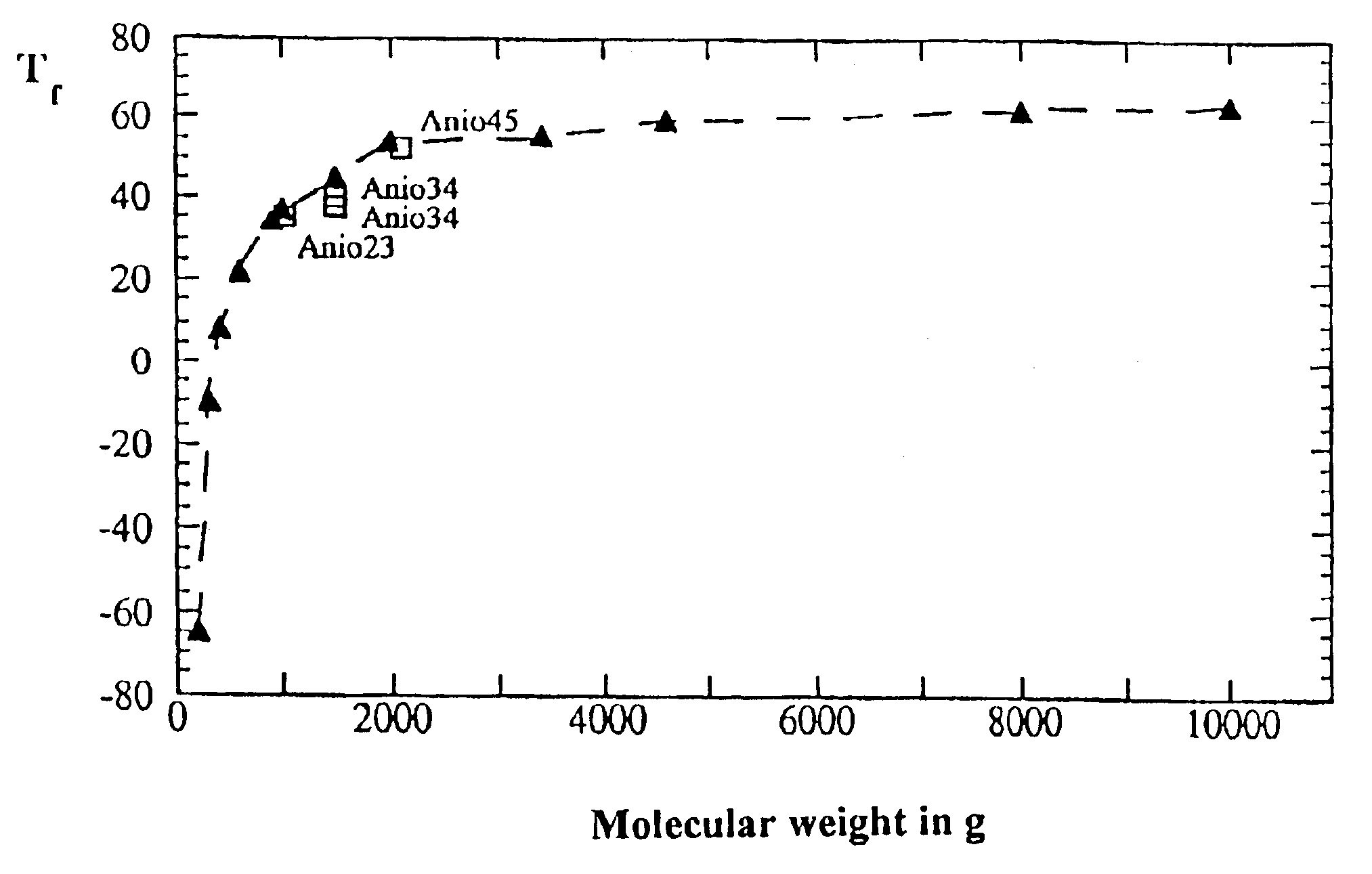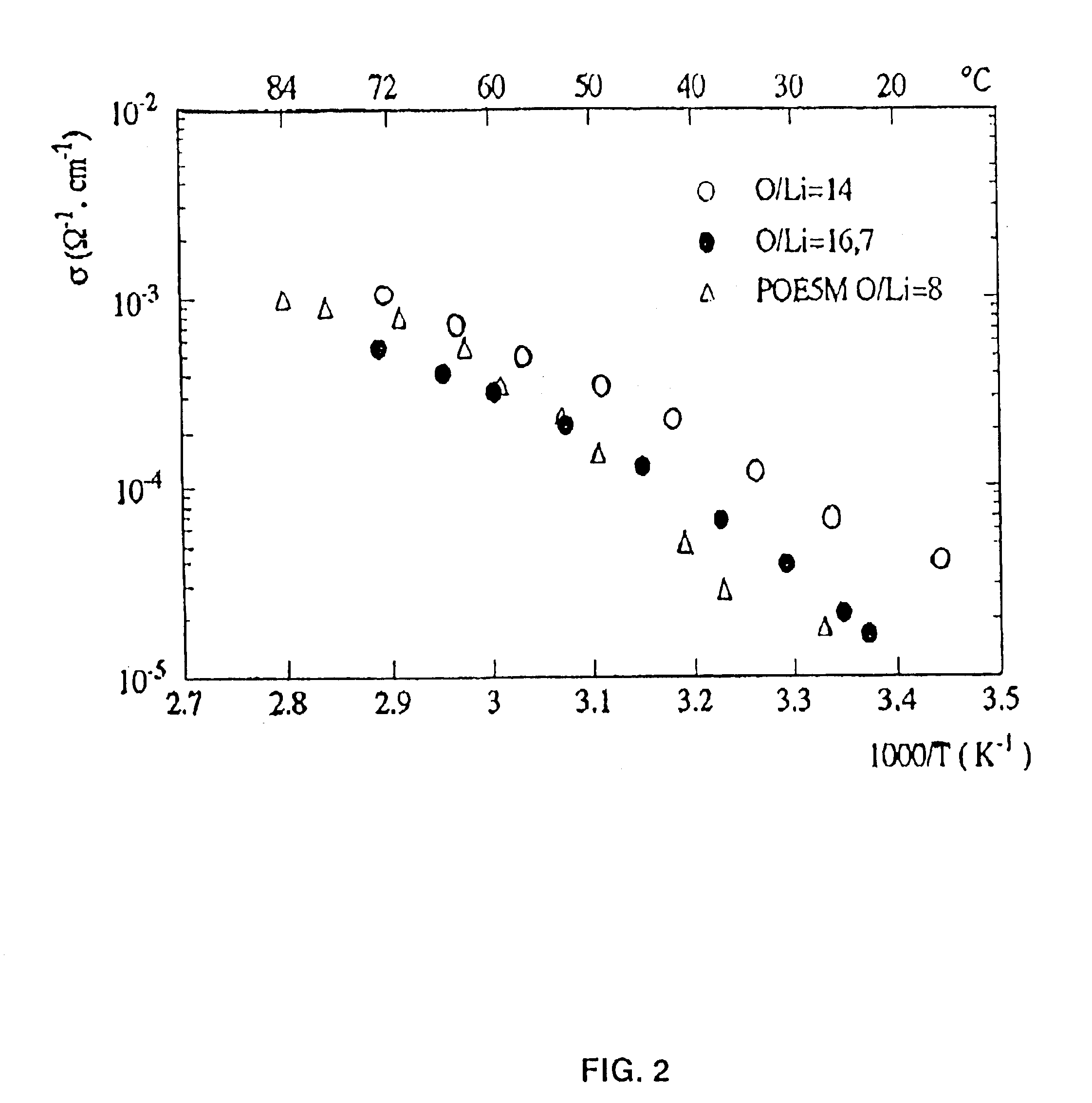Copolymer of ethylene oxide and at least one substituted oxirane carrying a cross-linkable function, process for preparation thereof and use thereof for producing materials with ionic conduction
a technology of ethylene oxide and oxirane, which is applied in the field of copolymer of ethylene oxide and at least one substituted oxirane carrying a cross-linkable function, can solve problems such as the possibility of obtaining oligomers, and achieve the effect of reducing the number of reactive ends and high polymerization yield
- Summary
- Abstract
- Description
- Claims
- Application Information
AI Technical Summary
Benefits of technology
Problems solved by technology
Method used
Image
Examples
example 1
[0052]In a reactor which is free from traces of water and impurities containing 250 ml of toluene, 10−3 mole of potassium tert-butanolate and 3 ml of THF, a mixture of 83.9 g of ethylene oxide, 10 g of methyl glycidyl ether and 5.1 g of allyl glycidyl ether was introduced. The temperature of the reactor was raised to 120° C. and maintained at that level for 22.5 hours. A decrease of the pressure from 10.3×105 Pa to 105 Pa was observed. The temperature was thereafter lowered to 70° C. and 100 mg of a sulfide of 3-tert-butyl-4-hydroxy-5-methyl-phenyl commercialized by Aldrich, was added, this product being used as stabilizing and anti-oxidizing agent for the polymer. The reactor was thereafter washed with a small quantity of toluene and 93 g of copolymer was recovered after evaporation of the solvent, which corresponds to a yield of 100%. The DSC analysis shows a melting peak Tf at 30° C. and a vitreous transition temperature Tg=−64° C. The average molecular mass in number, determined...
example 2
[0053]In a reactor free from traces of water and impurities and containing 115 ml of toluene, 2.10−3 mole of potassium tert-butanolate and 6 ml of THF, a mixture of 87.2 g of ethylene oxide, 9.8 g of methyl glycidyl ether and 5 g of allyl glycidyl ether was introduced at room temperature. The temperature of the reactor was raised to 120° C. and maintained at that temperature for 22 hours. A decrease of the pressure from 10.3×10−5 to 1.4×10−5 Pa was noted. 100 mg of a sulfide of 3-tert-butyl-4-hydroxy-5-methyl-phenyl in solution in 50 ml of toluene were thereafter added. The copolymer was recovered after evaporation of the solvent with a yield of 85%, the essential portion of the losses being due to the fact that a small quantity of copolymer remains stuck on the wall of the reactor. A DSC analysis shows a melting peak Tf at 30° C. and a vitreous transition temperature Tg=−61° C. The average molecular mass in number, determined by steric exclusion chromatography (SEC), is about 80,00...
example 3
[0054]In a reactor which is free from traces of water and impurities, 250 ml of toluene, 10−3 mole of potassium t-butanolate and 3 ml of THF were added. The temperature of the reactor was raised to 110° C. and, thereafter, a mixture of 90.2 g of ethylene oxide, 8.4 g of methyl glycidyl ether and 1.9 g of allyl glycidyl ether was added by means of a burette under pressure. The temperature of the reactor was raised to 120° C. and was kept at that level for 22 hours, during which a pressure decrease from 7.7×10−5 to 2.6×10−5 Pa was noted. The content of the reactor was thereafter poured into a glass flask containing 100 mg of 3-tert-butyl-4-hydroxy-5-methyl-phenyl sulfide under an atmosphere of argon. 94.4 g of copolymer were recovered after evaporation of the solvent, which corresponds to a yield of 94%, not taking into account the copolymer which was not extracted from the reactor. A DSC analysis shows a melt peak Tf at 33° C. and a vitreous transition Tg=−59° C. The average molecula...
PUM
| Property | Measurement | Unit |
|---|---|---|
| mass | aaaaa | aaaaa |
| humidity | aaaaa | aaaaa |
| boiling point | aaaaa | aaaaa |
Abstract
Description
Claims
Application Information
 Login to View More
Login to View More - R&D
- Intellectual Property
- Life Sciences
- Materials
- Tech Scout
- Unparalleled Data Quality
- Higher Quality Content
- 60% Fewer Hallucinations
Browse by: Latest US Patents, China's latest patents, Technical Efficacy Thesaurus, Application Domain, Technology Topic, Popular Technical Reports.
© 2025 PatSnap. All rights reserved.Legal|Privacy policy|Modern Slavery Act Transparency Statement|Sitemap|About US| Contact US: help@patsnap.com



